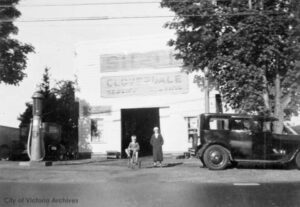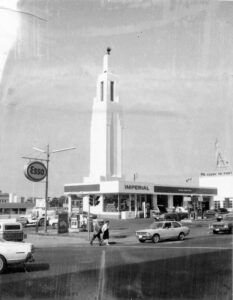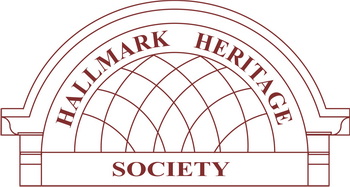Daily Colonist Islander Magazine – March 27, 1983.
Victoria’s Early Gas Stations – by Ian Baird.
A forgotten building in today’s community is the local gas station. I am sure many readers will remember as a youth going down to the corner garage for a cold drink or to watch the mechanic.
Canada’s first gas station was established by Imperial Oil’s Vancouver manager C. M. Rolston in 1908. It consisted of a “kitchen water tank on a concrete pillar and running a garden hose from it to the curb.”
Since those days the gas station has evolved into a multi-faceted operation.

Purely utilitarian, the first gas stations were enclosed by an open-faced shed, a no smoking sign and a chair for the attendant. In lieu of paint, posters sufficed as decoration.
Many businesses simply had a pump placed on the curb. Indeed, gasoline did not begin to be sold by the gallon until 1925. As late as the 1930s many motorists “were still simply pulling over and honking for the local storekeeper to come out and “fill” er up” from his curb pump.
Many longtime Victoria residence will remember Jim Bryant’s curbside pump service on the southeast corner of Johnson and Broad streets.
The old a service station on Vancouver Island was purported to be in the old Fountain Esso service station built in 1917. It was located at the corner of Gorge Road and Government Streets near the roundabout. Early owners were John and Murdo McDonald. The station was torn down in 1959 and replaced by a more modern structure now since removed.
As the automobile gained in popularity stations became more elaborate. Brick became the most popular building material and the station “usually looked like a cross between a small factory and the local jail.” At the same time local grocery stores began having gas pumps in front of their establishments to vie for the business of the motoring public. Existing examples are the stores at the corner of Metchosin and Happy Valley Roads and the two small stores at Saseenos near Sooke.
By 1918 automobile registration in Canada had passed the quarter of a million mark. The late 1920s saw station architecture change. Although Victoria has no examples from those early days, two surviving stations are of note. The Home station at the corner of Quadra and Finlayson streets is still in business while its counterpart, the former Texaco station on the View Royal Hill, is still standing although not operative.
The demise of the local gas station is nowhere more evident than in Oak Bay. Many residents will remember the Oak Bay Garage and Texaco station on Windsor Road. On the opposite corner was the late Charlie Miller’s Shell gas station which still stands and is now known as Autohaus Victoria Limited. Oak Bay had another Shell station, now removed, on the corner of Estevan and Cadboro Bay Roads. The Gulf Station on the same road is now the only gas station in Oak Bay. Of course, many former students of Oak Bay High School will recollect the Home station adjacent to the school.
Other municipalities too have experienced the demise of the neighbourhood gas station. A cursory glance at any early Victoria directory will illustrate the extent of their disappearance. Leading firms in those days were McMorran’s Garage at 727 Johnson Street and Revercomb Motors at 925 Yates Street. One veteran Victoria garage which recently closed its doors was Plimley’s dealership on Yates Street. It is to be hoped this fine example of commercial architecture will not be lost to the wrecker’s hammer.

One striking example still remaining, although no longer functioning as a service station, is the former Causeway Service Station at the corner of Government and Humboldt Streets. This station was designed and built by Imperial Oil in 1931 in the Art Deco style. Its outstanding architectural feature is the 72-foot-high tower. Originally this tower functioned as an aircraft beacon “possessing 10 million candlepower, revolving twice a minute and is visible for 10 miles.” Being on the waterfront, this station was in the unique position of being able to service seaplanes and marine craft.
Beginning in the 1940s service station design turn toward the International style, over all clinical and functional in appearance and the most obvious feature was the rectangular shape and large glassed areas. Much more attention was paid to the needs of the motoring public. A sales room displayed the companies’ products while clean decorative washrooms were provided.
Non-existent in early stations, motorists then expected these types of amenities. Clean and polished stations are essential to engage the motorist as, “a dealer with poor service or a dirty station soon loses his business to his rival was often just across the road or on the opposite corner.”
Now the trend is towards self-serve stations with many of the old stations dealing in repairs only. Some old gas stations have even become private dwellings.
The next time you are out for a drive and stop for gas at an old-style station, take note, it may not be there on your next outing.
